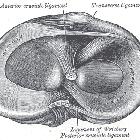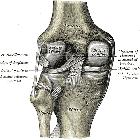meniscal tear












Meniscal tears are the failure of the fibrocartilaginous menisci of the knee. There are several types and can occur in an acute or chronic setting. Meniscal tears are best evaluated with MRI.
Pathology
Acute meniscal tears occur after the rotatory trauma of the knee, whereas chronic degenerative meniscal tears often occur in the elderly after minimal rotatory trauma or stress on the knee.
In older adults, attritional changes in the meniscus lead to fragmentation of the meniscus and a variety of tears (usually occur at the posterior horn of the medial meniscus) .
Types
There are different types of meniscal tears, describing the morphology of the injury. Identifying and accurately describing the type of meniscal tear can help the surgeon in patient education and planning of the surgical procedure. Meniscal tear types include :
- basic tears
- longitudinally oriented tears
- horizontal tear (cleavage tear)
- parallel to the tibial plateau involving one of the articular surfaces or free edge
- divides the meniscus into superior and inferior parts
- vertical tear
- perpendicular to the tibial plateau and parallel to the long axis of the meniscus
- divides the meniscus into medial and lateral parts
- Wrisberg rip - a specific lateral meniscus subtype
- ramp lesion - a specific medial meniscus subtype
- horizontal tear (cleavage tear)
- radial tear: perpendicular to both the tibial plateau and the long axis of the meniscus
- root tear: typically radial-type tear located at the meniscal root
- longitudinally oriented tears
- complex tear: a combination of all or some of horizontal, vertical, and radial-type tears
- displaced tear: tear involving a component that is displaced, either still attached to the parent meniscus or detached:
- flap tear: displaced horizontal or vertical tears
- bucket-handle tear: displaced vertical tear
- parrot beak tear: oblique radial tear
Radiographic features
Plain radiograph
On plain radiographs, meniscal tears are not visible. In rare cases secondary signs can be seen, such as a soft tissue swelling next to the meniscus when a meniscal cyst is present . Only when associated with more complex injuries plain film may suggest a meniscal tear, e.g. arcuate sign, reverse Segond fracture, tibial plateau fracture.
MRI
With a sensitivity of ~95% and a specificity of 81% for medial meniscal tears and sensitivity of ~85% and a specificity of 93% for lateral meniscal tears , MRI is the modality of choice when a meniscal tear is suspected, with sagittal images being the most sensitive .
There are three basic MR characteristics/criteria of meniscal tears :
- high intrameniscal signal extending to at least one articular surface, which should be seen in at least two slices: two slice touch rule (do not have to be contiguous, e.g. sagittal and coronal slices)
- distortion of the normal meniscal morphology if no prior surgery
Each type of meniscal tear has its own characteristics on MRI, but in most cases, the following can be seen :
- T1: a hyperintense line in the meniscus can be seen, but it is difficult to differentiate between degeneration and meniscal tear on this sequence; in the case of a bucket-handle tear an empty groove can sometimes be seen
- T2: a hyperintense line in the meniscus, which indicates synovial fluid in the meniscus
- the high T2 signal in mid-substance of the meniscus without extension to the surface is not necessarily a tear and can be:
- in adults: secondary to degeneration
- in children: high vascularity of meniscus
- the high T2 signal in mid-substance of the meniscus without extension to the surface is not necessarily a tear and can be:
See MRI grading system for meniscal signal intensity.
Associated features that are suggestive of a meniscal tear include :
- tibial subchondral bone edema
- parameniscal cyst
- meniscal extrusion
Treatment and prognosis
Surgical arthroscopy is done in most of the cases. Meniscopexy or complete or partial meniscectomy can be performed, depending on the degree and type of meniscal tear.
Pitfalls
- oblique ligament: with intercondylar bucket handle component
- transverse ligament
- meniscofemoral ligament
- meniscocapsular fibrofatty junction
- previous surgery
- fluid in normal central knee recesses
- fluid in popliteal hiatus
- ligamentum mucosum
- chondrocalcinosis: can increase signal intensity on MRI
Differential diagnosis
The differential can be variable, depending on the type of tear but in general, consider:
- meniscal degeneration (can be associated with a tear)
- meniscal contusion
- discoid meniscus
- meniscal flounce (rare)
- ring meniscus (rare)
- meniscal ossicle (rare)
Siehe auch:
- Raubersche Konsole
- Ligamentum meniscofemorale
- Ligamentum meniscofemorale posterius
- Ligamentum transversum genus
- Korbhenkelriss Meniskus
- Ligamentum meniscofemorale anterius
- Wrisberg-Variante des Scheibenmeniskus
- meniscal tear types
- komplexer Meniskusriss
- horizontal meniscal tear
- axial meniscal tear
- longitudinal meniscal tear
- oblique meniscal tear
und weiter:

 Assoziationen und Differentialdiagnosen zu Meniskusriss:
Assoziationen und Differentialdiagnosen zu Meniskusriss:





